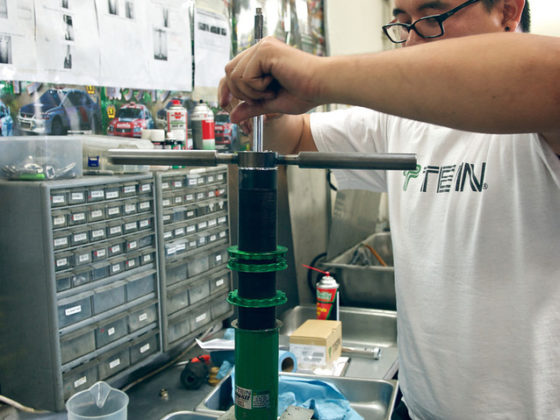ON THE STREET
The 12C is very utilitarian on the street. The ride height is not too low and the short overhangs don’t find many issues with the majority of driveways and city streets. While this is not the car to take to the golf course, there is a reasonable amount of room under the front trunk and behind the rear seats to store luggage for the weekend.
 |  |
Once you put the car in gear, the 7-speed Graziano “Seamless Shift Gearbox” (SSG) transaxle slips the clutch smoothly and seamlessly. McLaren really perfected the calibration of this transmission which feels more like an automatic in nature than the DCT transmissions in BMWs, GTRs, and even Ferraris. In automatic mode or grabbing gears from the steering wheel mounted paddles (which are mounted on a rocker and move together), the blending of the two clutches during gear changes is one of the smoothest of any DCT’s that I’ve driven. Almost to a fault since there is no sense of urgency or drama when you quickly climb to triple digits.
In Normal mode the car is quite docile and comfortable with minimal cabin noise. You can hold conversations with your passenger or on your phone without having to yell over the engine or road noise. The climate control and entertainment systems are within easy reach and once you know how everything works, they are quite intuitive. But like everything on the McLaren, you almost need to take a class on all of the systems to avoid stumbling around frustrated by your own incompetence.
While I have heard the ride quality described as being as good as that of a Cadillac, I wouldn’t go that far because while the dampers soak up bumps better than most performance luxury sedans, there is a slight impact harshness that is reminiscent of the spherical bearings in the suspension of a Porsche GT3. The 12C does not ‘crash’ over harsh bumps, but there is a noticeable lack of rubberized isolation (like a Cadillac) in the suspension over pavement transitions in the road which actually gives the driver more feel.
Speaking of feedback, the McLaren’s steering and feedback transmitted though the wheel is quite good. McLaren overcame the issues of an electric steering rack by opting for a hydraulic system, but instead of drawing power from the engine to run the pump and the losses of long power steering lines, McLaren uses an electric motor at the front of the car to power the hydraulic pump which is genius. While I really like the steering feel, the steering wheel itself feels a bit thin to me. This is a personal preference of course and having large hands could make me a little biased, but I do like the feel of a slightly thicker wheel.
If you flip the Powertrain (P) knob on the right to sport mode, the Intake Sound Generator (ISG – another fancy McLaren device which is an electronically damped tube that connects the car’s intake to the cabin) opens and the quiet, unassuming engine wakes up with a growl at low RPMs and screams on up to its 8,500rpm redline with pitch that you would expect from a small displacement flat plane crank V8 that is only slightly muted by its twin turbos. This does not make the car louder from the outside but it really improves the driving experience behind the wheel. Sport mode (and track mode to an even more aggressive extent) also changes the gearboxes programming to be more aggressive and responsive.
 The 12C replaces traditional swaybars with a suspension system that connects the dampers right to left. With the use of more computers, valves, and hydraulic accumulators; McLaren found even more passive systems in the car that they could replace with active electronic systems.
The 12C replaces traditional swaybars with a suspension system that connects the dampers right to left. With the use of more computers, valves, and hydraulic accumulators; McLaren found even more passive systems in the car that they could replace with active electronic systems.Turning the Handling (H) knob to sport mode tightens up the suspension by increasing the response of the 12C’s innovative swaybar-less interconnected hydraulic suspension and activates “Brake Steer”. That’s right, McLaren decided to completely ditch the conventional swaybar, which has been around almost as long as the car itself, in favor of an active system that controls body roll by connecting the hydraulics of the compression damping on one side of the car to the rebound damping on the other. McLaren debut their “Brake Steer” technology in their 1998 MP4/13 Formula 1 car which applies the brakes to individual wheels when cornering to help the car turn better than it could otherwise. Needless to say this technology was later banned in Formula 1.
With the use of computer-controlled valves and accumulators between the left and right side dampers, the 12C’s ingenious suspension is able to continuously vary the car’s front and rear roll stiffness throughout a corner. This is a huge advantage which gives the 12C an unlimited amount of potential to adjust the car’s handling since it can effectively vary how stiff the front and rear swaybars are corner by corner to fix unwanted oversteer or understeer. But this advantage opens up a whole new can of worms that has the potential of being both hazardous and brilliant, which is dependent on its programming. Since there is no mechanical linkages connecting the left and right sides of the car (unlike a swaybar) the 12C’s ride quality is greatly improved due to its independence over bumpy and uneven roads.
Overall the 12C is comfortable, easy to drive on the street, and not intimidating. The only real negative is ingress/egress but the dihedral doors make for plenty of room to jump out of the car even if you’re parked next to another car.
ON THE TRACK
The first time I ever drove an NSX was back in 2006 at Buttonwillow. Although it was a silver 500whp Turbocharged NSX, I fell in love with the car. 8 years later I find myself again at Buttonwillow but this time behind the wheel of a silver 515whp McLaren MP4-12C.
After pressing the Active button, selecting Track mode for both Handling (H) and Powertrain (P), and tapping the Manual and Aero buttons, I was ready to hit the track. Once I left the pits, I grabbed a few gears and am still very impressed with the smooth ‘seamless’ gear changes of the dual clutch transmission. Compared to most DCT’s which abruptly slam through the gears; the McLaren perfectly blends the release of the lower gear with the engagement of the next. Like taking off in a plane, this smooth acceleration doesn’t give the perception of speed, but on track it puts down power very well without shocking the drivetrain on upshifts. While the 12C is not a naturally aspirated V8, I have always been a turbo guy and really like the sound of this car as it screams to its 8,500rpm redline.
 We used Motec’s C125 Dash to log all of our data via the car’s OBD port. Approaching 137mph on the front straight, the 12C brakes with over 1G of deceleration before entering Turn 1. With a 63.6mph minimum cornering speed, the 12C pulls just over 1.10 G’s on average through Turn 1 which is very impressive for stock aero and street tires.
We used Motec’s C125 Dash to log all of our data via the car’s OBD port. Approaching 137mph on the front straight, the 12C brakes with over 1G of deceleration before entering Turn 1. With a 63.6mph minimum cornering speed, the 12C pulls just over 1.10 G’s on average through Turn 1 which is very impressive for stock aero and street tires.The Pirelli PZero Corsas took a few corners to build heat into them but once warm, they developed a lot of grip. The 12C’s steering is very precise and communicative with a nice amount of steering weight. I would still prefer a slightly thicker wheel but it’s hard to complain when you get this much feedback through it. The 12C is very nimble and responsive but to my surprise there was on-throttle and high-speed, steady-state understeer. The front of the car has a great turn-in but the rear grip overpowers the front.
 In order to maintain an aero platform without compromising the ride quality like stiffer springs would, McLaren utilized a “Z”-bar heave-spring which is essentially a “U”-shaped swaybar with one end rotated 180-degrees to form a “Z”. As the 12C creates downforce, the rear does not squat because the “Z” twists with vertical travel while it has not effect in roll.
In order to maintain an aero platform without compromising the ride quality like stiffer springs would, McLaren utilized a “Z”-bar heave-spring which is essentially a “U”-shaped swaybar with one end rotated 180-degrees to form a “Z”. As the 12C creates downforce, the rear does not squat because the “Z” twists with vertical travel while it has not effect in roll.


